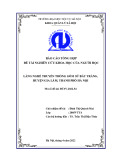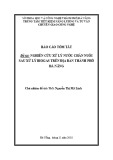
Ets-1/ Elk-1 is a critical mediator of dipeptidyl-peptidase III
transcription in human glioblastoma cells
Abhay A. Shukla, Misti Jain and Shyam S. Chauhan
Department of Biochemistry, All India Institute of Medical Sciences, New Delhi, India
Introduction
Dipeptidyl-peptidase III (DPP-III), a cytosolic amino-
peptidase has been purified and characterized from dif-
ferent tissues of various animal species such as rat and
human skin [1,2], bovine and human cataractous lens
[3], rabbit and human erythrocytes [4], rat brain [5]
and pancreas [6], monkey brain [7], human placenta
[8], neutrophils [9], Saccharomyces cerevisiae [10] and
Drosophila melanogaster [11]. All mammalian DPP-IIIs
require zinc ions for their maximum activity and have
therefore been termed metalloaminopeptidases. The
crystal structure of yeast DPP-III has been described
by Baral et al. [12], providing an insight into its cata-
lytic mechanism and mode of substrate binding. No
endogenous substrate for this enzyme has yet been
identified. However, it has broad specificity for a num-
ber of polypeptides, suggesting its involvement in the
terminal stage of intracellular protein catabolism.
Interestingly, DPP-III activity has been reported to
increase in retroplacental serum [8] suggesting that it is
synthesized in placental cells and released into the
maternal circulation. In view of its high affinity for
angiotensin II and III [13], the potential role of this
Keywords
5¢-RACE; electrophoretic mobility shift
assays; promoter; site-directed
mutagenesis; transcription factors
Correspondence
S. S. Chauhan, Room No. -3009,
Department of Biochemistry, All India
Institute of Medical Sciences, New Delhi
110029, India
Fax: +91 11 2658 8663
Tel: +91 11 2659 3272
E-mail: s_s_chauhan@hotmail.com
Database
The nucleotide sequence of the human
DPP-III promoter has been submitted to the
GenBank database under the accession
number FJ793449
(Received 9 November 2009, revised 25
December 2009, accepted 1 February 2010)
doi:10.1111/j.1742-4658.2010.07603.x
Dipetidyl-petidase III is a metallopeptidase involved in a number of physi-
ological processes and its expression has been reported to increase with the
histological aggressiveness of human ovarian primary carcinomas. Because
no information regarding the regulation of its expression was available,
experiments were designed to clone, define and characterize the promoter
region of the human dipeptidyl-peptidase III (DPP-III) gene. In this study,
we cloned a 1038 bp 5¢-flanking DNA fragment of the human DPP-III
gene for the first time and demonstrated strong promoter activity in this
region. Deletion analysis revealed that as few as 45 nucleotides proximal to
the transcription start site retained 40% of the activity of the full-length
promoter. This promoter lacked the TATA box but contained multiple GC
boxes and a single CAAT box. Similarly, two Ets-1 ⁄Elk-1-binding motifs
are present in the first 25 nucleotides from the transcription start site. Bind-
ing of Ets-1 ⁄Elk-1 proteins to these motifs was visualized by electropho-
retic mobility shift and chromatin immunoprecipitation assays. Mutations
of these binding sites abolished not only binding of the Ets protein, but
also the intrinsic promoter activity. Increased DNA-binding activity of
Ets-1 ⁄Elk-1 by v-Ha-ras also augmented the mRNA level and promoter
activity of this gene. Similarly, co-transfection of DPP-III promoter–repor-
ter constructs with Ets-1 expression vector led to a significant increase in
promoter activity. From these results, we conclude that Ets-1 ⁄Elk-1 plays a
critical role in transcription of the human DPP-III gene.
Abbreviations
ChIP, chromatin immunoprecipitation; CLR, Chang liver Ras cells; CLDR, Chang liver DRas cells; DPP-III, dipeptidyl-peptidase III; EMSA,
electrophoretic mobility shift assay; ERK, extracellular regulated kinase; Inr, initiator element; MEK, mitogen-activated protein kinase kinase.
FEBS Journal 277 (2010) 1861–1875 ª2010 The Authors Journal compilation ª2010 FEBS 1861






























